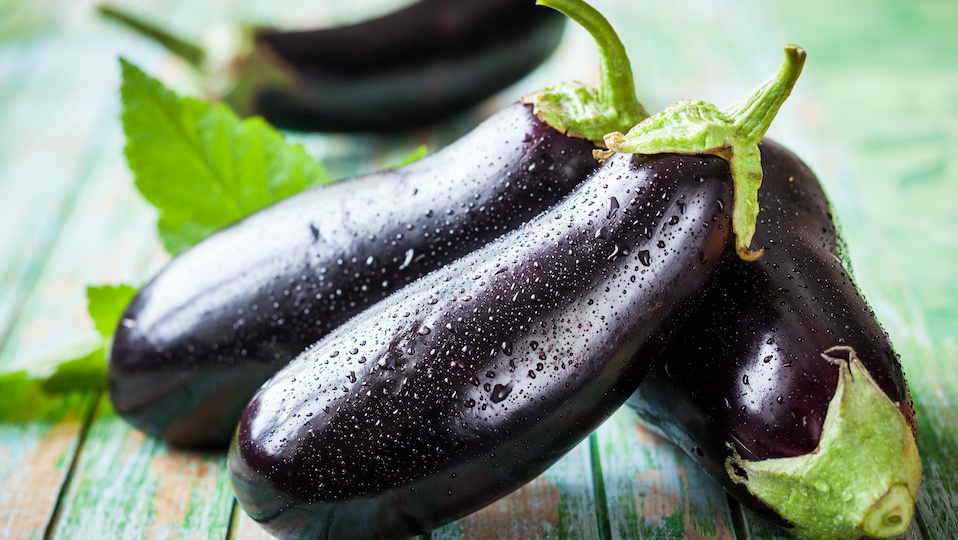Eggplant, also known as aubergine or brinjal, is a favorite in Mediterranean cuisine. Additionally, it’s low-calorie, provides fiber and nutrients, and makes an excellent grilling vegetable. However, eggplant can be tricky to grow. Nevertheless, with these tips, you’ll be harvesting your eggplant just in time for your favorite Italian feast. If you love eggplant, there’s no reason why you can’t make it the star of your garden. Here’s how to grow, harvest, and store it!
How to grow eggplant (Solanum melongena)
Did you know that eggplant is actually a perennial? Although gardeners treat eggplant as an annual, it typically grows wild in its homeland of South Asia, according to The Old Farmer’s Almanac. Since they are native to a tropical climate, eggplants do require relatively high temperatures to grow, similar to peppers and tomatoes, which, like eggplant, are in the Nightshade family. In fact, they grow fastest when temperatures reach 70 and 85°F.
Eggplants grow several feet in height and hang from branches like their cousin, the tomato. Keep in mind, you’re not limited to growing the large varieties. Try growing small variety eggplants, which produce small fruits. These compact varieties also grow well in containers if you are space-deprived in your garden. Whether you grow heirloom varieties like Morden Midget, or the European favorites, Pot Black and Patio Baby, these bushy eggplants yield many secondary branches as the growing season progresses. Here’s how to grow these beauties.
Start from transplant or from indoors
Since eggplants need warm soil, there’s really no rush to start your seeds early. It’s best to purchase six- to eight-week-old transplants when daytime temperatures are around 70 to 90 degrees F. Nighttime temps should be 65 to 70 degrees F. Additionally, when purchasing transplants, buy high-quality species. Stay away from spindly plants or young plants with blossoms, or you will have a lower yield of fruit. Don’t plant transplants into your garden until after the last threat of frost. Alternatively, you can also start your plants indoors. Seeds germinate in five days at a temperature of 86 degrees F, suggests the United States Of Agriculture (USDA) Plant Guide. However, at lower temps of 68 degrees F, they may require up to 13 days to germinate.
Prepare your planting site
- For best results, choose a very sunny spot in your garden.
- For optimal growth, your soil pH should be between 5.8 to 6.5, according to The Old Farmer’s Almanac. Additionally, soil should be a well-drained loam, high in organic matter.
- Cover your soil with black plastic mulch to warm the ground before planting.
- Eggplant generally requires a lot of fertilizer. So, use an organic fertilizer throughout the planting bed about a week prior to planting.
- For container planting, use a dark-colored container that will absorb as much sunlight as possible. You’ll need a large, five-gallon container. Additionally, it should be placed outside, in full sun, for pollination to occur. Don’t forget to use a quality potting mix to avoid disease.
How to plant your eggplant
- Like tomatoes, eggplants require stakes from the get-go. Add a stake an inch or two from the plant to provide support as they climb.
- When transplanting, plant three- to four-inch seedlings, about two feet apart — in rows three to four feet apart.
- After planting, make sure to water well. Finish with a layer of mulch to hold moisture and suppress weeds from growing.
- Continue to water the soil so that moisture reaches six inches into the ground. Your soil should retain moisture — but never be soggy. Constant watering is key.
How to harvest eggplant
- You can harvest your eggplant about 65 to 80 days after transplanting, depending on the variety. When germinating from seed, you can expect your eggplant to mature approximately 100 to 120 days later.
- To check for ripeness, look for fruit with shiny and unwrinkled skin that’s a uniform color. Once the skin does not rebound to gentle pressure, it’s ripe and ready to harvest.
- Waiting too long to harvest will yield a fruit with tough seeds suggests the USDA.
- Don’t pull the eggplant — it won’t come off. Instead, cut the fruit with pruning shears, close to the stem. Leave about an inch of the stem attached. If all goes well, you’ll likely get a harvest at least once or twice a week.
How to store eggplant
Properly stored, eggplant will usually stay fresh for about five to seven days in the refrigerator. For optimal freshness, store your eggplant in a plastic bag. Do not wash or cut your eggplant before storing it in the refrigerator. Doing so will damage the skin, and the fruit will spoil quickly once exposed.
You can also freeze eggplant for about eight months.
- Simply wash, peel and cut into one-third inch slices.
- Next, blanch the eggplant by plunging it into boiling water for four minutes.
- To prevent discoloration, add 1/2 cup lemon juice to boiling water.
- Remove eggplant quickly and dip into a cold-water ice bath to stop the cooking process.
- Drain off excess moisture and place in airtight containers or freezer bags. Freeze immediately.
Enjoy your harvest!
-Katherine Marko




